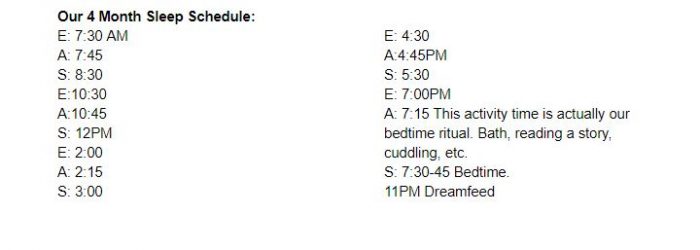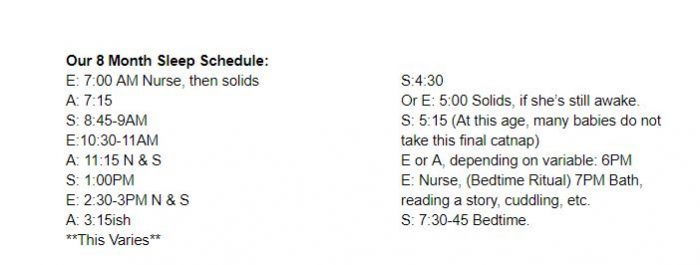How to Get Your Crazy Baby on a Sleep Schedule
Are things feeling a little chaotic? You know you need a little structure in your life. Your baby’s naps are erratic, the nights are worse. Maybe a friend told you to look into a baby sleep schedule, or perhaps you’ve been winging until now and just can’t do it anymore.
Whatever your reasons, you’ve come to the right place.
Honestly? I’m just a girl that loves her sleep. I’m a new, inexperienced mom that (until I popped out one of these tiny creatures) knew nothing about babies. Yet, my daughter is on a fantastic baby sleep schedule and I get oodles of sleep at night and plenty of free blogging time during the day.
Hint: it’s not because I’m a super mom.
I managed to find the perfect baby sleep routine. It’s not the kind that is rigid either. It’s personalized for my needs and my daughter’s. My ultimate goal is to help you figure out how to get your baby on the perfect baby sleep schedule for her.
I’m here to tell you that it is not too late to get your baby on a great sleep schedule. As a matter of fact, this post is specifically for babies 4 months and older.
This is part two of my baby sleep tutorials.
Before we get started if you haven’t already read my post How to Start the Perfect Baby Sleep Schedule, read it now. I promise, it’s just as beneficial as this post. It discusses everything you need to get started with this step-by-step tutorial: like what a baby sleep schedule is ( it’s probably not what you think!), how to deflect criticism for starting a baby sleep schedule, and the absolute bare minimum you need to get started.
I’ll give you a moment to go do that, and then we’ll get started!
**Just a note **I wrote this guide specifically for babies 4 months and older. 3 month baby sleep schedules are a gray area. You might get lucky and be able to use the methods in my sister post, 5 Simple Steps to Start an Amazing Newborn Sleep Schedule. Or, your baby’s bad sleep habits could already be ingrained and you’ll have to use the methods in this post.**
Welcome back!
If your baby is over 4 months old and has never been on any sort of baby sleep schedule, please don’t feel bad. It’s extremely common for mothers to not even think about a schedule before that point. I think the biggest part is the misconception of what a baby sleep schedule is.
In case you didn’t read the last post, the baby sleep schedule, I’m going to talk to you about is better defined as a routine.
What’s the difference?
Schedules are mostly rigid. They stifle your baby’s needs (and your convenience) in the name of the clock. A routine is flexible, it works for you, and it addresses all of your baby’s physiological and emotional needs.
The Best Baby Sleep Schedule for Babies 4 Months and Older
That secret to a perfect baby sleep schedule for babies 4 months and older? I learned it from a few books. In this post, I reference On Becoming Babywise and the Baby Whisperer Solves All Your Problems pretty frequently.
These books are a new mom’s salvation.
While I’m going to give you the steps you need to get started, these books can give you the information you need to actually thrive with a baby sleep schedule for babies 4 months and older. Let’s face it, my experience is limited to myself and my baby. These books offer the experience and knowledge of trained professionals.
On Becoming Babywise is my personal favorite, but if you’re limited to investing in just one book, you may want to try the Baby Whisperer instead.
Tracy Hogg was the ultimate baby troubleshooter and her FAQ and troubleshooting guides cover just about every situation you could come across. When you’re dealing with a baby (or, let’s face it, a toddler…) that has already shown signs of independence and has already developed some bad habits, you’re going to need a step-by-step simple approach that won’t overwhelm you. Babywise has some great tips, but as far has practical steps to implement a routine, the Baby Whisperer definitely wins.
How to Start a Baby Sleep Schedule for Babies 4 Months and Older
Step 1: Prepare
Learning how to start a baby sleep schedule for babies 4 months and older requires a little more effort than a newborn. In addition to the requirements, I listed out in the last post, make sure you also do the following:
- If you’re a stay-at-home mom, clear your schedule. This will ensure the fastest results. If not, you should start the observation step during the week and then the actual training during the weekend.
- Get plenty of rest beforehand. Depending on your baby’s current habits, you might need it. (Sorry to scare you, Mama!)
Observe Your Baby’s Current Routine
“Uh, Erin, my baby isn’t on a routine. That’s why I’m here!”
Well, kind of. Humans, in general, are creatures of habit. Even if your baby isn’t on a routine that you made, chances are, she’s using some kind of pattern to go about her day.
For the first 2, (maybe 3 if you need to build up courage) days, observe:
- When does she typically like to eat
- How long does she sleep
- What time does she usually clunk out for the night?
- Identify what sleep props are hindering her sleep. If you’re not sure what this might be, check out my post Why Won’t Your Baby Sleep.
If it were me, I would get rid of any sleep props during this process. Start fresh, you know? But, depending on your baby (or toddler’s) age, that might be too much to add on to your plate.
(You can use my sleep troubleshooting worksheet to help you notice the pattern.)
Related: Why Your Baby Won’t Sleep: 7 Surprising Things That Kill a Baby’s Sleep
Step 2: Make Your “Schedule”
Yay! The fun part!
Remember…it might be helpful to think of this as a flexible routine, not a rigid schedule. The point of a written schedule is to help you keep the end goal in mind, organize your day, and prevent you from falling into oblivion the next time you have a domestic disaster.
NOT to stress you out!
The best baby sleep schedules are the perfect combinations of what will work best for you and your baby’s natural rhythms.
Research Realistic Sleep Expectations
A 4 month old sleep schedule varies quite a bit from a 6 month old sleep schedule. So, it wouldn’t be a bad idea to check to see where your baby is at. That way you don’t have any unrealistic expectations.
There’s a great article from the Chronicles of a Babywise Mom that lists the general baby sleep expectations. Obviously, your baby may vary from these figures, but it’s great guideline to help you plan.
What Does Your Routine Look Like?
Look at your schedule and figure out when convenient feeding times will be. For example, when my daughter was a newborn, I scheduled her bedtime to coincide with my husband’s arrival from work.
For simplicity sake, I’m going to use the Baby Whisperer’s version of the routine (E.A.S.Y.) to show you what our early schedule was.


There are three things I want to point out for the schedules above:
- Look at the difference between a 4 month schedule and an 8 month sleep schedule! See how different they are?
- Keep in mind that my 8 month sleep schedule could be your 6 month sleep schedule. We are just entering into the 4 hour feeding periods, which is a little rare for babies on a routine.
- Note the estimates and variables in the 8 month sleep schedule? Baby sleep schedules vary much more as they get older. This is totally normal. It might be a transition month, maybe he’s starting to drop a nap, going through a growth spurt, or mixing things up because of his new mobility. While an IDEAL nap is 2 hours, it can easily be shorter.
This is why I call our “schedule” a flexible routine. You’re not married to an EXACT time, though you should try to at least strive for a 30 minute window. The idea of the routine is to give your life structure, not condemn you to a stopwatch or stress you out.
Step 3: Begin Routine Bootcamp with Your Desired Wake Time
You’re going to want to begin this step on a weekend, when you can fully dedicate yourself to implementing the routine. If you can take a few days off work, even better. This is the hardest step, and the longest.
Remember our desired waketime? That is ESPECIALLY important here. The Baby Whisperer recommends waking up at 7AM. If you want to make your desired wake time later after you’ve solidified the routine, that’s cool. But for now, I highly recommend following her advice.
Even if your baby likes to snack all night and he just fell asleep, wake him up at 7 anyway.
If he likes to wake up at the crack of dawn, that’s a little trickier. Your baby needs to stay in his crib until your desired wake time. That means that there might be some crying. If you’re the Cry-It-Out type, you can let him do that . However, if you’re not, the Baby Whisperer has an excellent no-cry method called the Pick-Up, Put-Down.
You can also read more information about sleep training methods in my post, Baby Sleep Training: Everything You Need to Know.
Rules:
- You do not play with your baby until the desired wake time.
- Don’t cave and let him sleep in your bed
The night before make sure your baby takes a nice, full feeding. If, during this step, you are terrified that you’re starving your baby then feed him and put him back in his crib. Just remember, do not socially engage until your desired wake time.
Related: Baby Sleep Training: Everything You Need to Know
Step 4: Begin Your Day Right with Awake Time
At your desired wake time, begin your activity period. Diaper change, play time, whatever.
If your baby is old enough for solids, I would feed him the solids immediately after nursing/bottle time. Even though she may have just had a full liquid feeding, I usually find that my baby eats more at the beginning of her awake time. Plus, this eliminates the risk of snack feeding.
Step 5: Use a Naptime Ritual and Put Your Baby Down for a Nap
For the sake of this post, I’m going to assume that you’ve already researched sleep rituals and have one planned.
When to Start
If your baby is over 4 months, she can probably stay awake 2 hours before taking her first nap (There’s a gray area here, since your baby may be super tired from the night time). Typically, at about 1.5-1.75 hours of awake time (when she shows signs of tiredness), I begin to wind things down. I take her to her room, change her diaper, put on her sleep sack, cuddle, and sing her a song. The lights are dim and there’s nothing that can stimulate her. The entire process takes about 10 minutes.
If your baby is completely unfamiliar with the concept of naptime routines/ fought you the entire night before, chances are you’re going to need a lot more time.
Don’t get frustrated if your baby fights you. You’re asking a lot of him here. He’s taking a nap when you want him to…which is an entirely new concept!
Once again, he may fight you. The goal is to get your baby to fall asleep in his own crib until the next feeding. You may have to employ your favored sleep training method again.
Step 6: Repeat for the Next Feedings
At the end of the “nap time” (whether she’s crying or sleeping), make sure you feed her. This begins the cycle. Since we are establishing a brand new routine, you’re going to want to make this as close to the 3-4 hour (whichever one applies to your baby) as possible.
Even if she’s sleeping, wake her up. If your goal is to be on a routine but you’re letting your baby sleep past the 3 hour feeding mark, he’ll make up for the feeding somewhere else.
Repeat this pattern throughout the day.
**Just a note on the evening wake cycle**My baby gets cranky about this time of the day. Sometimes she likes to take a long nap, other times she barely takes a nap at all. The evening hours are tricky for older babies. Your baby may be at the stage where she can go from 4:30ish to bedtime without a catnap or you may not. If she’s showing signs of tiredness at this stage, you may want to try for that catnap.)
Step 7: After the last feeding, begin your Bedtime Routine
For the sake of moving forward, I’m assuming you have a bedtime routine decided on. Begin that process after your 7PM feeding.
My advice: keep this awake cycle really chill. I tend to stick with soothing activities, like a bath, story time, or cuddling. I also keep the lights dim and speak in a softer voice.
Make sure your baby is in bed by your desired bedtime, in her own bed. Just like your desired wake time, this is crucial to establishing the routine.
Step 8: Keep Nighttime, Nighttime!
Your baby is going to sleep in his own bed until 7AM.
Man, that’s a loaded statement.
If your baby raised hell during the day, chances are he willat night too. Once again, the method of sleep training should be something that YOU feel comfortable with. Whatever method you choose, remember to be consistent.
Can I feed my baby at night?
Most research indicates that babies are fully capable of sleeping through the night by 3 months. Having said that, I say trust your mommy gut. If you truly believe your baby is crying out hunger, don’t ignore it. Most of the time, once your routine is established, the night feeding will resolve itself. Until then, it won’t hurt to give your baby one feeding.
Just remember the ground rules:
- If you do feed your baby, put her right back in the crib afterwards
- Change diaper only if necessary
- No play time
- Keep talking and interactions to an absolute minimum
- Keep the room dark
- Don’t cave and let him sleep with you
- Be patient
How to Know if Your Baby Really Needed that Night Feed
I added this mini-section because the fear of starving my baby was the absolute worst part of sleep training. So, here’s my experience.
If she takes a full feeding, you’ll know that you made the right choice. If she suckles just for five minutes and just wants to cuddle, it was a false alarm. Not a big deal! Just put your baby back into her crib, and file that experience away.
Keep an eye on the first feeding of the day too. Usually, if you give an older baby a full feeding in the middle of the night but they don’t take a full feeding in the morning, that night feeding is extraneous.
Dream Feed
If your baby is asleep around 10-11PM, and you know he’s going to wake up in the middle of the night hungry, you can try a dream feed. If you’re new to the concept, around 10-11PM you feed your baby in her sleep. For some babies, it can take some time to train them to take the feeding, especially for breastfed babies.
If your baby is over 7 months, don’t bother.
Step 9: Repeat Yesterday’s Routine
Congratulations! You’ve made it to the next day. WOW!! How are you doing?
Now, do it again. And again. And again. If you’ve made it this far and have remained consistent, chances are you’ve probably noticed a little bit of improvement. If not, don’t feel bad! The older your baby, the harder it is.
But it does get better!
Step 10: Expect to Make Modifications to the Baby Sleep Schedule
For the one-millionth time, don’t make this a rigid schedule. A great routine is something that follows you for your whole life.
So, when I say, expect to make modifications, I’m not talking about throwing your routine to the wind and winging it again.
The thing is, just when you have a pretty good routine down, your baby will change (especially if you have an older baby). She’ll drop that third catnap. She’ll go through a growth spurt. Or maybe she’ll become an early riser. Who knows?
Adjust accordingly for these occurrences, but make sure you adjust the rest of the routine as well. Especially in the first days of the routine when you are just figuring it all out.
A flexible routine is freeing, but only if you allow it to be. If you’re too rigid (like me at times), your routine will frustrate you and you’ll go back to chaos. If you’re too lax, your baby will start to control your day again.
“You’ll never change your life until you change something you do daily. The secret of your success is found in your daily routine.”
I love, love, love that quote because it is so true–for you and your baby. By implementing a routine into your baby’s life you are being intentional. You’re helping your baby form healthy habits that can literally shape her life. In our chaotic world, we need a firm foundation. A routine is a small foundation that your baby can fall back on and gain a sense of security.
I hope that encourages you, Mama. Starting a baby sleep schedule for babies 4 months and older is not easy. It’s going to test your patience and your commitment. Just keep your mind on the end goal: the overall benefit to you and your baby.
What happens if you’ve successfully implemented a great baby sleep schedule and your baby is still not sleeping?
First, keep in mind how long you’ve been on the routine. It takes a while for all of the wrinkles to be smoothed out. Second, you may want to check out my post, Why Your Baby Won’t Sleep: 7 Surprising Things That Kill Baby Sleep and download my Sleep Troubleshooting Guide. It’s a helpful little tool. Plus, handing over your email will give you access to my other freebies and biweekly newsletter.
Pinterest truly is an endless resource. Check out my pins on Pinterest (Board is on this page’s sidebar) for a TON of other baby sleep tips and personal experiences from other mom bloggers.
I hope this post helps you create your baby sleep schedule. Most of all, I hope it removes much of the chaos from your day.
Let me know how it goes!






